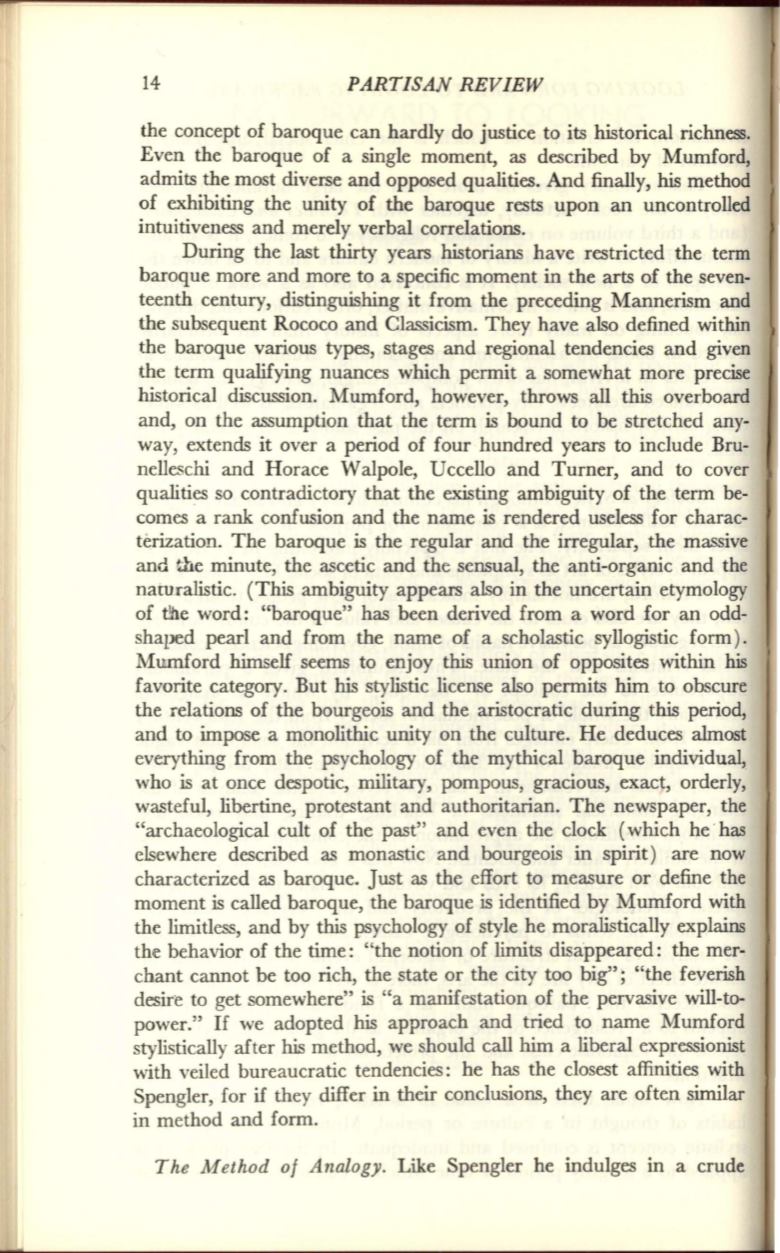
14
PARTISAN REVIEW
the concept of baroque can hardly do justice to its historical richness.
Even the baroque of a single moment, as described by Mumford,
admits the most diverse and opposed qualities. And finally, his method
of exhibiting the unity of the baroque rests upon an uncontrolled
intuitiveness and merely verbal correlations.
During the last thirty years historians have restricted the tenn
baroque more and more to a specific moment in the arts of the seven–
teenth century, distinguishing it from the preceding Mannerism and
the subsequent Rococo and Classicism. They have also defined within
the baroque various types, stages and regional tendencies and given
the term qualifying nuances which permit a somewhat more precise
historical discussion. Mumford, however, throws all this overboard
and, on the assumption that the term is bound to be stretched any–
way, extends it over a period of four hundred years to include Bru–
nelleschi and Horace Walpole, Uccello and Turner, and to cover
qualities so contradictory that the existing ambiguity of the term be–
comes a rank confusion and the name is rendered useless for charac–
terization. The baroque is the regular and the irregular, the massive
and the minute, the ascetic and the sensual, the anti-organic and the
naturalistic. (This ambiguity appears also in the uncertain etymology
of t!he word: "baroque" has been derived from a word for an odd–
shaped pearl and from the name of a scholastic syllogistic form ).
Mumford himself seems to enjoy this union of opposites within
his
favorite category. But his stylistic license also permits him to obscure
the relations of the bourgeois and the aristocratic during this period,
and to impose a monolithic unity on the culture. He deduces almost
everything from the psychology of the mythical baroque individual,
who is at once despotic, military, pompous, gracious, exact, orderly,
wasteful, libertine, protestant and authoritarian. The newspaper, the
"archaeological cult of the past" and even the clock (which he ' has
elsewhere described as monastic and bourgeois in spirit) are now
characterized as baroque. Just as the effort to measure or define the
moment is called baroque, the baroque is identified by Mumford with
the limitless, and by this psychology of style he moralistically explains
the behavior of the time: "the notion of limits disappeared: the mer–
chant cannot be too rich, the state or the city too big"; "the feverish
desire to get somewhere" is "a manifestation of the pervasive will-to–
power."
If
we adopted his approach and tried to name Mumford
stylistically after his method, we should call him a liberal expressionist
with veiled bureaucratic tendencies: he has the closest affinities with
Spengler, for if they differ in their conclusions, they are often similar
in method and form.
The M ethod of A nalogy.
Like Spengler he indulges
III
a crude


